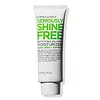What's inside
What's inside
 Key Ingredients
Key Ingredients

 Benefits
Benefits

 Concerns
Concerns

 Ingredients Side-by-side
Ingredients Side-by-side

Water
Skin ConditioningPropylene Glycol
HumectantButylene Glycol
HumectantCetearyl Alcohol
EmollientCaprylic/Capric Triglyceride
MaskingDimethicone
EmollientCeteareth-20
CleansingAluminum Starch Octenylsuccinate
AbsorbentSilica Silylate
EmollientBehenyl Alcohol
EmollientPhenoxyethanol
PreservativeDicetyl Phosphate
EmulsifyingCeteth-10 Phosphate
CleansingSalicylic Acid
MaskingPanthenol
Skin ConditioningParfum
MaskingBoron Nitride
AbsorbentBambusa Arundinacea Stem Extract
Skin ConditioningAloe Barbadensis Leaf Juice
Skin ConditioningMaltodextrin
AbsorbentSodium Hydroxide
BufferingWater, Propylene Glycol, Butylene Glycol, Cetearyl Alcohol, Caprylic/Capric Triglyceride, Dimethicone, Ceteareth-20, Aluminum Starch Octenylsuccinate, Silica Silylate, Behenyl Alcohol, Phenoxyethanol, Dicetyl Phosphate, Ceteth-10 Phosphate, Salicylic Acid, Panthenol, Parfum, Boron Nitride, Bambusa Arundinacea Stem Extract, Aloe Barbadensis Leaf Juice, Maltodextrin, Sodium Hydroxide
Water
Skin ConditioningSorbitan Stearate
EmulsifyingC15-19 Alkane
SolventCetearyl Alcohol
EmollientJojoba Esters
EmollientCetyl Alcohol
EmollientIsopentyldiol
HumectantGlycerin
HumectantHydroxypropyl Starch Phosphate
Dimethicone
EmollientTapioca Starch
Sorbityl Laurate
EmulsifyingSalicylic Acid
MaskingNiacinamide
SmoothingCaprylyl Glycol
EmollientXanthan Gum
EmulsifyingPanthenol
Skin ConditioningChamomilla Recutita Flower Extract
MaskingBisabolol
MaskingTetrahexyldecyl Ascorbate
AntioxidantPolymethylsilsesquioxane
Benzoic Acid
MaskingBenzyl Alcohol
PerfumingPropylene Glycol
HumectantDehydroacetic Acid
PreservativeDextrin
AbsorbentAmylopectin
Polydextrose
HumectantCitric Acid
BufferingWater, Sorbitan Stearate, C15-19 Alkane, Cetearyl Alcohol, Jojoba Esters, Cetyl Alcohol, Isopentyldiol, Glycerin, Hydroxypropyl Starch Phosphate, Dimethicone, Tapioca Starch, Sorbityl Laurate, Salicylic Acid, Niacinamide, Caprylyl Glycol, Xanthan Gum, Panthenol, Chamomilla Recutita Flower Extract, Bisabolol, Tetrahexyldecyl Ascorbate, Polymethylsilsesquioxane, Benzoic Acid, Benzyl Alcohol, Propylene Glycol, Dehydroacetic Acid, Dextrin, Amylopectin, Polydextrose, Citric Acid
Ingredients Explained
These ingredients are found in both products.
Ingredients higher up in an ingredient list are typically present in a larger amount.
Cetearyl alcohol is a mixture of two fatty alcohols: cetyl alcohol and stearyl alcohol. It is mainly used as an emulsifier. Emulsifiers help prevent the separation of oils and products. Due to its composition, it can also be used to thicken a product or help create foam.
Cetearyl alcohol is an emollient. Emollients help soothe and hydrate the skin by trapping moisture.
Studies show Cetearyl alcohol is non-toxic and non-irritating. The FDA allows products labeled "alcohol-free" to have fatty alcohols.
This ingredient is usually derived from plant oils such as palm, vegetable, or coconut oils. There is debate on whether this ingredient will cause acne.
Due to the fatty acid base, this ingredient may not be Malassezia folliculitis safe.
Learn more about Cetearyl AlcoholDimethicone is a type of synthetic silicone created from natural materials such as quartz.
What it does:
Dimethicone comes in different viscosities:
Depending on the viscosity, dimethicone has different properties.
Ingredients lists don't always show which type is used, so we recommend reaching out to the brand if you have questions about the viscosity.
This ingredient is unlikely to cause irritation because it does not get absorbed into skin. However, people with silicone allergies should be careful about using this ingredient.
Note: Dimethicone may contribute to pilling. This is because it is not oil or water soluble, so pilling may occur when layered with products. When mixed with heavy oils in a formula, the outcome is also quite greasy.
Learn more about DimethiconePanthenol is a common ingredient that helps hydrate and soothe the skin. It is found naturally in our skin and hair.
There are two forms of panthenol: D and L.
D-panthenol is also known as dexpanthenol. Most cosmetics use dexpanthenol or a mixture of D and L-panthenol.
Panthenol is famous due to its ability to go deeper into the skin's layers. Using this ingredient has numerous pros (and no cons):
Like hyaluronic acid, panthenol is a humectant. Humectants are able to bind and hold large amounts of water to keep skin hydrated.
This ingredient works well for wound healing. It works by increasing tissue in the wound and helps close open wounds.
Once oxidized, panthenol converts to pantothenic acid. Panthothenic acid is found in all living cells.
This ingredient is also referred to as pro-vitamin B5.
Learn more about PanthenolPropylene Glycol is an odorless, colorless liquid. As a humectant, it helps skin retain moisture. It also aids in delivering active ingredients.
Another role of this ingredient is preventing a product from melting or freezing. Propylene glycol also adds antimicrobrial properties to a product, elongating product lifespan.
This ingredient is considered an organic alcohol and commonly added into both cosmetics and foods.
Those with sensitive skin or conditions may develop a rash when using this ingredient.
Learn more about Propylene GlycolSalicylic Acid (also known as beta hydroxy acid or BHA) is a well-known ingredient for treating skin that struggles with acne and clogged pores. It exfoliates both the skin's surface and deep within the pores to help clear out buildup, control oil, and reduce inflammation.
Unlike AHAs (alpha hydroxy acids), salicylic acid is oil-soluble. This allows it to penetrate into pores which makes it especially effective for treating blackheads and preventing future breakouts.
Salicylic acid is also known for its soothing properties. It has a similar structure to aspirin and can calm inflamed or irritated skin, making it a good option for acne-prone skin that is also sensitive.
Concentrations of 0.5-2% are recognized by the U.S. FDA as an over-the-counter topical acne product.
It can cause irritation and/or dryness if one's skin already has a compromised moisture barrier, so it's best to focus on repairing that before introducing this ingredient into your routine.
While salicylic acid does not increase sun sensitivity, it’s still important to wear sunscreen daily to protect your skin.
If you are looking for the ingredient called BHA or Butylated Hydroxyanisole, click here.
Learn more about Salicylic AcidWater. It's the most common cosmetic ingredient of all. You'll usually see it at the top of ingredient lists, meaning that it makes up the largest part of the product.
So why is it so popular? Water most often acts as a solvent - this means that it helps dissolve other ingredients into the formulation.
You'll also recognize water as that liquid we all need to stay alive. If you see this, drink a glass of water. Stay hydrated!
Learn more about Water